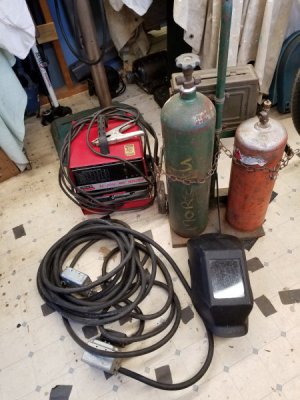Hey everyone,
Just though I would update you on my welder decision. After reading over the thoughtful response's to this thread and then letting everything percolate in the back recesses of my mind, along with taking a 3 hour hands on introduction to welding (o/x, stick, mig) at “The Forge” a makerspace downtown, I decided to purchase a small o/x setup and a arch welder. I just keep coming back to “boy it would be neat” to take up o/x and stick welding again.
Prior to my introduction to welding course I had a 100 amp panel installed in my 10'x14' shed with 11 110 and 4 220 outlets. One of the 220 outlets is a dedicated 30 amp 10/3 wire. It sure is nice to have all of those outlets along with 6 overhead led lights! This is a one person shop so no issue with overloading circuits as I only run one machine at a time.
So within the past few weeks I purchased a small set of o/x/tanks and cart (no hose, etc at this point). I also purchased a used Lincoln AC-225C arch welder with a 100' 10/4 extension cord, Jackson non-auto darkening helmet and a bunch of old 6011 and 6013 rods. According to the manual the Lincoln can run on a 50 amp #10, for up to 100' feet so I will change out my 30 amp breaker for a 50. The 100' extension cord will come in handy as I will not be doing any welding inside my wood shed and future plans are to build a small detached lean-to/pole barn shed for welding/blacksmithing.

I have several welding projects in mind from brazing/re-cutting a missing broken bull gear tooth on my Logan lath. Someone on this forum posted a picture from Practical Machinist that showed a home made jig (something to build/wed) for indexing off an existing tooth. And the ubiquitous run-of-the-mill welding table and welding cart build.
Found out last week that our local scrap yard, D.H Griffin, has a yard sale area and took a look at it last week. Looks like a gold mind of used scrap metal to practice welding and learning the proper techniques of metal prep prior to welding. Also will be on the look out for appropriate cart and welding table materials.
I retired (71 ½ and about time!) last November and feel like a kind in a candy store with all of this retirement time to indulge in my new found (started acquiring equipment about 3 years ago) metal working hobbies (lathe/etc, welding, backsmithing) and time.
So a final thanks to everyone for their kind, thoughtful and incisive responses in helping me decide on my welding solution's.
Harry
Just though I would update you on my welder decision. After reading over the thoughtful response's to this thread and then letting everything percolate in the back recesses of my mind, along with taking a 3 hour hands on introduction to welding (o/x, stick, mig) at “The Forge” a makerspace downtown, I decided to purchase a small o/x setup and a arch welder. I just keep coming back to “boy it would be neat” to take up o/x and stick welding again.
Prior to my introduction to welding course I had a 100 amp panel installed in my 10'x14' shed with 11 110 and 4 220 outlets. One of the 220 outlets is a dedicated 30 amp 10/3 wire. It sure is nice to have all of those outlets along with 6 overhead led lights! This is a one person shop so no issue with overloading circuits as I only run one machine at a time.
So within the past few weeks I purchased a small set of o/x/tanks and cart (no hose, etc at this point). I also purchased a used Lincoln AC-225C arch welder with a 100' 10/4 extension cord, Jackson non-auto darkening helmet and a bunch of old 6011 and 6013 rods. According to the manual the Lincoln can run on a 50 amp #10, for up to 100' feet so I will change out my 30 amp breaker for a 50. The 100' extension cord will come in handy as I will not be doing any welding inside my wood shed and future plans are to build a small detached lean-to/pole barn shed for welding/blacksmithing.

I have several welding projects in mind from brazing/re-cutting a missing broken bull gear tooth on my Logan lath. Someone on this forum posted a picture from Practical Machinist that showed a home made jig (something to build/wed) for indexing off an existing tooth. And the ubiquitous run-of-the-mill welding table and welding cart build.
Found out last week that our local scrap yard, D.H Griffin, has a yard sale area and took a look at it last week. Looks like a gold mind of used scrap metal to practice welding and learning the proper techniques of metal prep prior to welding. Also will be on the look out for appropriate cart and welding table materials.
I retired (71 ½ and about time!) last November and feel like a kind in a candy store with all of this retirement time to indulge in my new found (started acquiring equipment about 3 years ago) metal working hobbies (lathe/etc, welding, backsmithing) and time.
So a final thanks to everyone for their kind, thoughtful and incisive responses in helping me decide on my welding solution's.
Harry


 . Harry please do not swap a 50A in place of a 30 on #10. If you’re out of spaces on the panel then add a sub-panel.
. Harry please do not swap a 50A in place of a 30 on #10. If you’re out of spaces on the panel then add a sub-panel.